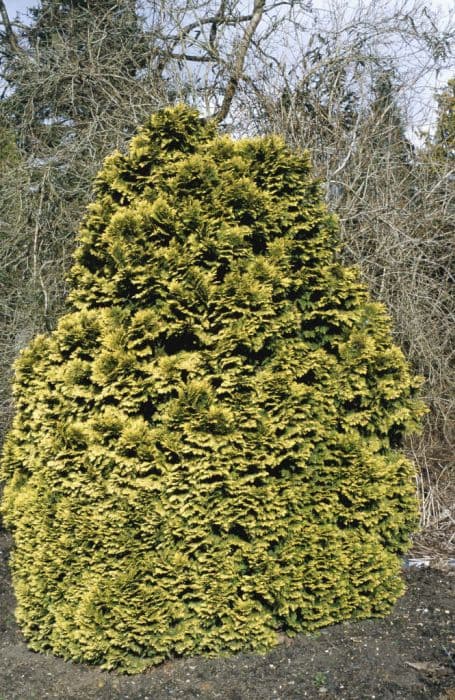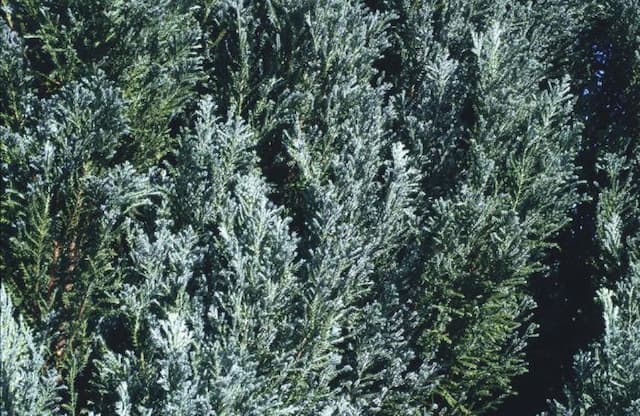Western Red Cedar Thuja plicata 'Zebrina' (v)

ABOUT
The Zebrina Western Red Cedar is a visually striking evergreen with notable variegated foliage. The plant displays an attractive mix of green and creamy yellow patches on its leaves, creating a pattern that resembles the stripes of a zebra, hence its common name. The foliage is arranged in flat sprays, with the individual leaves being scale-like and closely overlapping each other. These sprays are lush and give the plant an overall dense texture that can add depth and contrast to garden landscapes. The creamy yellow stripes are more pronounced on the new growth, which adds a bright aspect to the evergreen backdrop. As an ornamental variant of the Western Red Cedar, the Zebrina creates visual interest throughout the year with its unique coloration, making it a popular choice for gardeners looking to add a splash of color to their plant collection.
About this plant
 Names
NamesFamily
Cupressaceae
Synonyms
Zebrina Western Red Cedar, Zebrina Giant Arborvitae
Common names
Thuja plicata 'Zebrina' (v).
 Toxicity
ToxicityTo humans
Thuja plicata 'Zebrina', commonly known as Western Red Cedar, is not typically considered highly toxic to humans. However, ingestion of foliage or other parts of the plant in significant quantities can potentially cause gastrointestinal upset, such as nausea, vomiting, and diarrhea. It's important to handle plants with care and to avoid ingestion as a general safety practice.
To pets
In pets, the Western Red Cedar can be toxic if ingested. Consumption can lead to gastrointestinal upset, resulting in symptoms like vomiting, diarrhea, and abdominal pain. In some cases, more serious symptoms can occur, such as muscular weakness and difficulty breathing. If you suspect your pet has ingested part of this plant, it's important to contact a veterinarian promptly.
 Characteristics
CharacteristicsLife cycle
Perennials
Foliage type
Evergreen
Color of leaves
Green
Height
20 feet (6 meters)
Spread
10 feet (3 meters)
Plant type
Tree
Hardiness zones
5
Native area
North America
Benefits
 General Benefits
General Benefits- Ornamental Appeal: Thuja plicata 'Zebrina', commonly known as the Western Red Cedar, has striking foliage with yellow and green stripes, making it an attractive addition to landscapes.
- Habitat Support: Provides habitat and food for wildlife, such as birds and small mammals, which may use the tree for nesting or shelter.
- Privacy Screening: With its dense growth, it serves as an excellent natural privacy barrier for yards and gardens.
- Windbreak: Can be used to reduce wind speeds in areas, protecting gardens and homes from strong winds.
- Noise Reduction: The thick foliage can help to dampen noise pollution, creating a quieter environment.
- Shade Provider: Large size at maturity offers considerable shade, which can reduce energy costs in nearby homes by cooling the environment.
- Erosion Control: The root system helps to stabilize soil and prevent erosion, especially on slopes or in areas with loose soil.
- Easy Maintenance: Once established, it requires minimal care and is relatively low maintenance, making it suitable for a variety of landscapes.
- Drought Tolerance: Can tolerate periods of dry weather once established, making it suitable for regions with occasional water restrictions.
- Adaptability: Adapts to a range of soil types, though it prefers moist, well-drained soil, making it a versatile choice for many locations.
 Medical Properties
Medical PropertiesThis plant is not used for medical purposes.
 Air-purifying Qualities
Air-purifying QualitiesThis plant is not specifically known for air purifying qualities.
 Other Uses
Other Uses- The aromatic wood of the Western Red Cedar can be used in crafting furniture, giving it a natural, pleasant scent and deterring moths and other insects.
- Wood shavings and chips from the Western Red Cedar can be used as mulch in gardens, helping to suppress weeds and conserve soil moisture.
- The fibrous bark of the Western Red Cedar can be processed into a raw material for creating ropes, mats, and traditional weaving crafts by indigenous peoples of the Pacific Northwest.
- Due to its resistance to decay, the wood of Western Red Cedar is used for outdoor construction projects like decking, fencing, and landscape features.
- Western Red Cedar branches can be incorporated into floral arrangements or used as greenery in decorations due to their texture and color contrast.
- The Western Red Cedar's dense foliage provides an excellent habitat and nesting sites for birds and other small wildlife, supporting biodiversity.
- Wood from the Western Red Cedar is used to make shingles and shakes for roofing, thanks to its durability and weather-resistant properties.
- The plant is often used in hedges or privacy screens due to its fast-growing nature and dense foliage, providing natural barriers in landscaping designs.
- In boat building, the lightweight and rot-resistant timber of Western Red Cedar is prized for crafting kayak and canoe frames.
- Western Red Cedar wood can be used in the construction of musical instruments like guitars and soundboards for its tonal properties.
Interesting Facts
 Feng Shui
Feng ShuiThe Western Red Cedar is not used in Feng Shui practice.
 Zodiac Sign Compitability
Zodiac Sign CompitabilityThe Western Red Cedar is not used in astrology practice.
 Plant Symbolism
Plant Symbolism- Everlasting Life: Thuja plicata 'Zebrina' is also known as the Western Red Cedar, an evergreen tree symbolizing eternal life due to its long lifespan and persistent foliage.
- Protection: The Western Red Cedar has been historically used by indigenous peoples to create protective barriers, indicating its association with safety and shelter.
- Cleansing: This plant is often connected with purification rituals, as its leaves and wood emit a pleasant aroma that was believed to cleanse the air and spirit.
- Healing: Thanks to its medicinal properties, the Western Red Cedar signifies health and healing, as it was traditionally used in various remedies.
- Unity: With its widespread use in community building, such as in the construction of totem poles and community structures, the Western Red Cedar is a symbol of unity and togetherness.
 Water
WaterThe Western Red Cedar 'Zebrina' should be watered deeply and thoroughly, ensuring that the soil is moist but not waterlogged. During the growing season, watering once a week with about 1.5 to 2 gallons per each watering session is usually sufficient. In hot, dry weather, you may need to water more frequently, but it's important to let the soil dry out slightly between waterings. During the winter, you can reduce the frequency of watering since the plant's water requirements decrease. Always check the top inch of soil for dryness to decide if additional water is needed.
 Light
LightThe Western Red Cedar 'Zebrina' thrives best in full sun to partial shade. It ideally should be planted in a spot that receives at least four to six hours of direct sunlight each day, though it can tolerate some shade. Avoiding deep shade is important as it may lead to sparse foliage and a less robust plant.
 Temperature
TemperatureWestern Red Cedar 'Zebrina' can withstand a wide range of temperatures once established. It can survive minimum temperatures down to approximately -20°F and is comfortable in areas where maximum temperatures do not exceed 80°F. Ideally, the temperature range for this plant should be between 40°F to 75°F for optimal growth.
 Pruning
PruningPruning the Western Red Cedar 'Zebrina' is done to maintain shape, remove damaged or diseased branches, and encourage denser growth. Pruning should take place in late winter or early spring before new growth starts. This plant does not require heavy pruning; light trimming annually or biannually is often enough.
 Cleaning
CleaningAs needed
 Soil
SoilThe Western Red Cedar 'Zebrina' prefers a well-draining soil mix composed of loam, sand, and organic matter, which ensures adequate drainage and aeration. The ideal soil pH for this cultivar is between 6.0 and 7.5, leaning towards slightly acidic to neutral. Amending the soil with compost or peat moss can help to achieve the desired pH and provide the necessary nutrients for healthy growth.
 Repotting
RepottingWestern Red Cedar 'Zebrina' is typically grown outdoors and does not require frequent repotting. For smaller specimens grown in containers, repotting may be necessary every 2-3 years to refresh the soil and provide additional space for root growth. It is important to repot in spring before the new growth starts.
 Humidity & Misting
Humidity & MistingWestern Red Cedar 'Zebrina' thrives in outdoor conditions and does not require specific humidity levels when planted in the ground. However, if grown in a container, ensuring the ambient outdoor humidity is generally sufficient. It is adaptable to a wide range of humidity conditions in its hardiness zones.
 Suitable locations
Suitable locationsIndoor
Place in bright light, ensure ample space, and water regularly.
Outdoor
Plant in moist, well-drained soil, full sun to part shade.
Hardiness zone
5-7 USDA
 Life cycle
Life cycleWestern Red Cedar 'Zebrina' (variegated) begins its life as a seed, which germinates in moist, well-drained soil, often requiring a period of stratification to break dormancy. Seedlings initially develop a taproot and grow slowly, focusing energy on establishing a strong root system. As it matures into a sapling, the tree exhibits rapid vertical growth and starts developing its distinctive scale-like leaves, which are variegated in this cultivar. During its juvenile phase, 'Zebrina' develops its pyramidal shape and can be pruned to maintain desired density and form. As an adult, the Western Red Cedar 'Zebrina' reaches reproductive maturity, producing small cones that contain seeds for propagation. The plant can live for many years, becoming a large tree if not pruned and reaching the final stage of its lifespan when growth slows, and it eventually succumbs to environmental factors, disease, or old age.
 Propogation
PropogationPropogation time
Spring to Summer
The most popular method to propagate the Western Red Cedar 'Zebrina' is through semi-hardwood cuttings. This technique is typically carried out in late summer, after the new growth has started to harden but before it becomes completely woody. Gardeners select healthy, disease-free branches and take cuttings about 6 to 8 inches long. At the bottom end of the cutting, the leaves are removed from the lower third to create a bare stem, which is then dipped in rooting hormone to encourage root development. The prepared cuttings are inserted into a well-draining potting mix, ensuring that the bare stem is securely planted and that the foliage does not touch the soil. The cuttings are then kept in a warm, humid environment with indirect light until roots form, which usually takes several weeks. Regular misting helps maintain the necessary humidity, but it's vital to keep the soil moist, not soggy, to prevent the cuttings from rotting.









